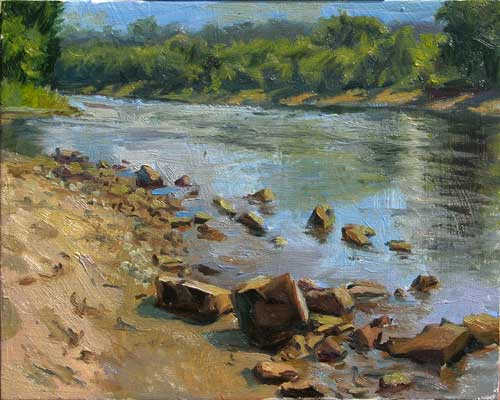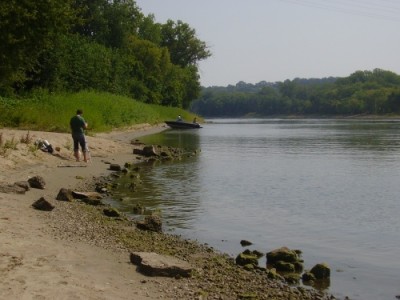Mississippi River Rocks in Full Sun | plein air painting to last the whole winter
You know how you sometimes stop and think to yourself, “I’m going to have to remember this feeling?” I had one of those moments while I was out painting last Sunday.
I was down on the Saint Paul bank of the Mississippi River with my mother for another plein air painting outing. The sky was blue and free of clouds. Wildflowers were blooming on the shore behind us. Passing boats sent waves of warm water to crash gently against my bare feet and the legs of my tripod. Then I had a thought: Summer is almost over.
I would guess that in other parts of the world, the end of summer is not that big of a deal. In Minnesota, however, it’s not so much the end of summer but the approach of winter that has this outdoor painter concerned. I’m sure that I can–and will–go out painting after the leaves have fallen and the flurries have begun; it just won’t be the same. At the very least, I’ll have to start to wear more layers. But who knows, it might be fun to invest in a couple of sled dogs to carry me and my supplies down to the frozen river. I do suppose that once the snow comes, however, I will have to forgo the part about painting barefoot in the sand.

What about now? Are the good times over?
Until then, however, the weather is beautiful! And the late-morning sun served up a great challenge: painting rocks in full sun. It was a fantastic opportunity to work on my artist goal of creating visual texture in a painting.
I think it is incredibly important to set artistic goals. Why? When you start a painting with a goal, you can pick a location or subject matter that helps to support your efforts and goal by providing challenges that force you come up with solutions. Additionally, when you find yourself out in the wild and ready to paint, you can very quickly become overwhelmed with all of the visual information around you. Having a goal helps to prioritize what you are going to attempt in a painting, and what you are going to edit out of your picture. In this case boaters, fishermen and swimmers came and went, but as you can see, I chose to leave my composition wild looking.
Somewhere between a rock and a hard edge.
For this painting, I wanted to focus on the feeling of the rocks. Being seen under strong late-morning sun creates strong shadows. You see this in the sharp, angular feel as the planes or facets of the rock turn away from the sun.
To put it another way, how do you describe the feeling of a rock? Hard, rough, jagged. How do you describe that visually with paint? Each plane or side of the rock is going to be hit with more or less sunlight depending on the direction it faces–toward or way from the sun. With our rocks, as you move from one plane to the next, the transition is very abrupt. This is where the rough, jagged feeling comes from. When I was in art school, this was called a hard edge. In contrast, imagine you are looking at a smooth, round ball under the same lighting condition. The light would gradually transition from the full sun on the top of the ball to the shadow on the under side of the ball. The planes have been rounded out, and the transition from light to shadow is smooth. Your eye moves from light to shadow very easily. This is called a soft edge.
Hard edges in painting draw the viewer’s eye. They call attention. From a texture stand point, hard edges create the feeling of firmness, and of an abrupt or dramatic change. A soft edge lets the viewer’s eye glide right on through a painting. As for texture, soft edges show an easy transition– a feeling of softness.
I was able to capture the feeling of the rocks in the painting above by using both hard and soft edges and contrasting them against one another: the hard edges of the main grouping of rocks is contrasted against the softer brush work found in the sand on the river bank in the lower left of the painting.



